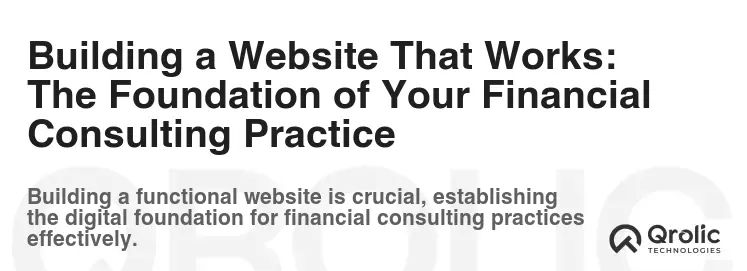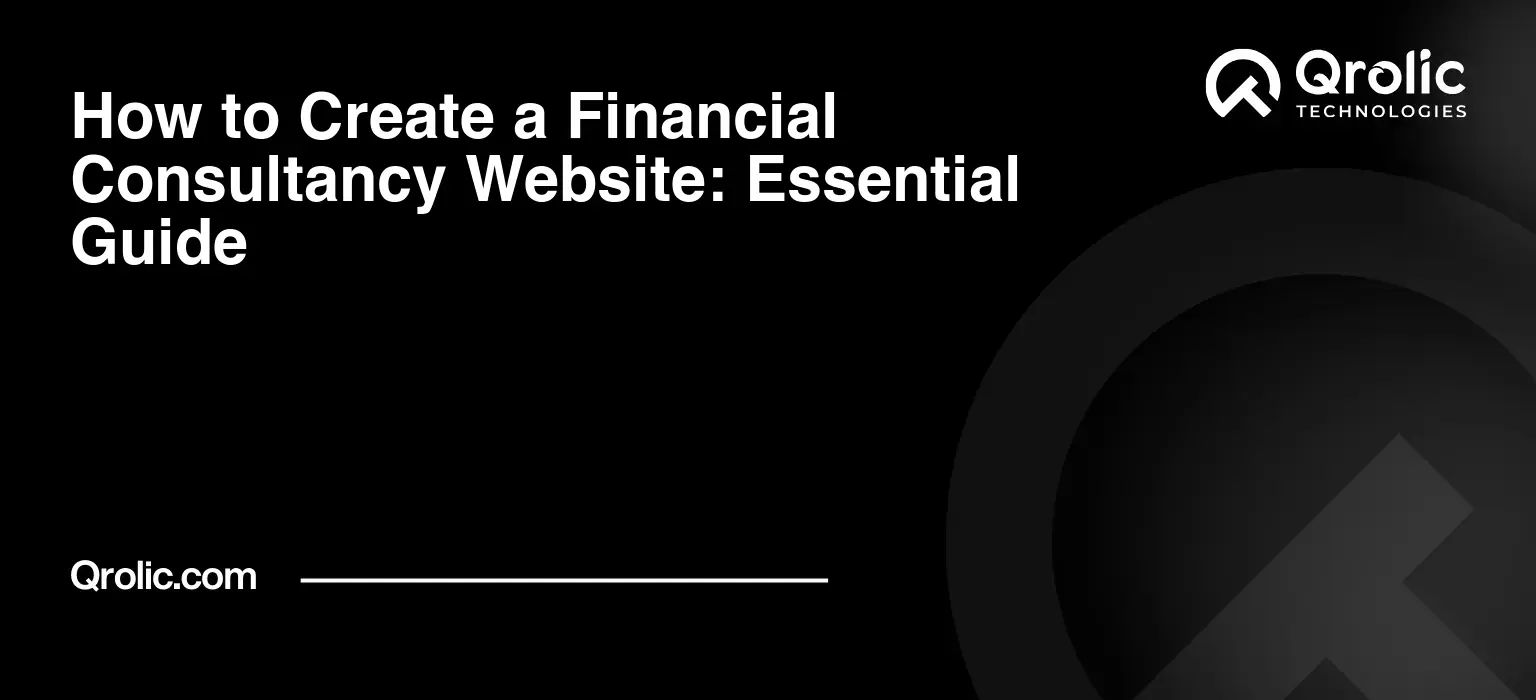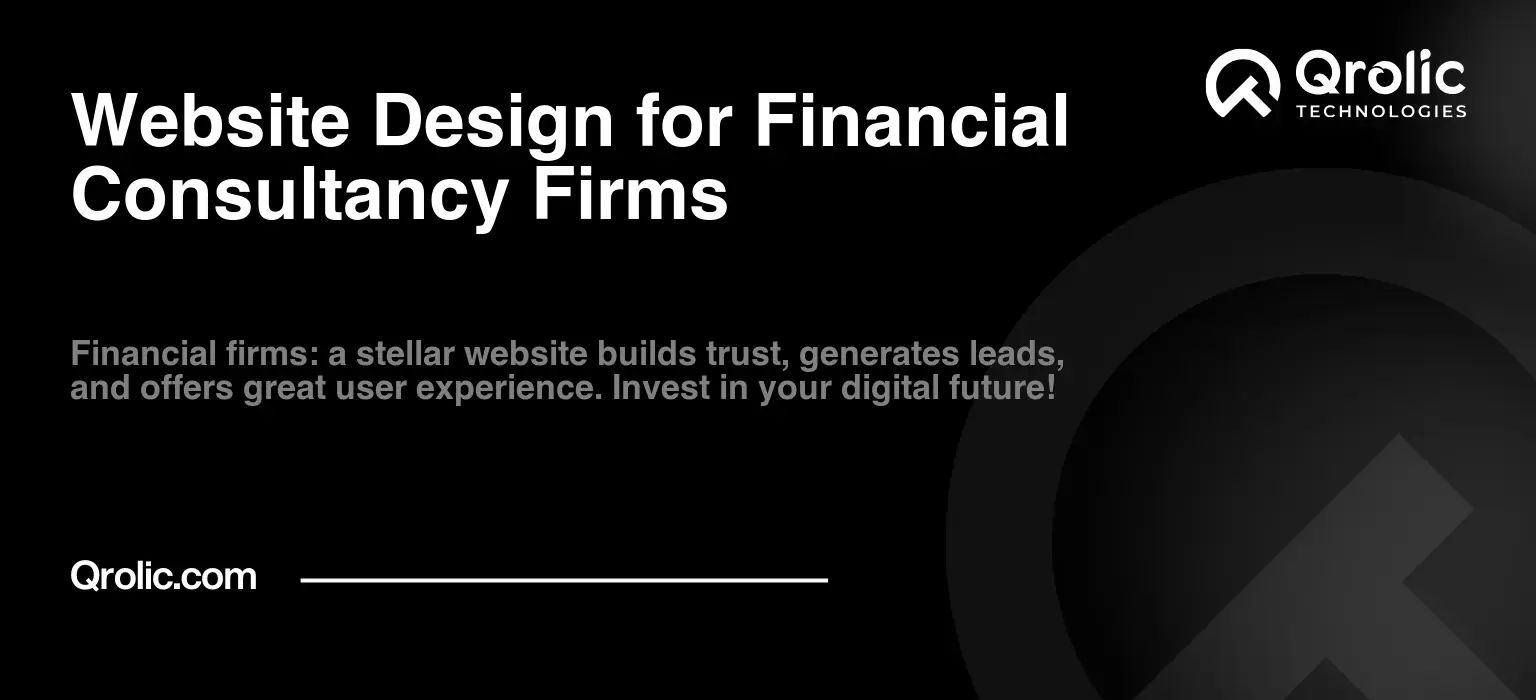Quick Summary:
- Clearly show your unique value and financial expertise.
- Build trust with client success stories and clear services.
- Make it easy to book appointments and capture leads.
- Use content and SEO to attract and track growth.
Table of Contents
- Building a Website That Works: The Foundation of Your Financial Consulting Practice
- 1. Crystal-Clear Value Proposition: Answering “Why Choose You?” Instantly
- 2. Compelling About Us Page: Building Trust and Establishing Credibility
- 3. Clearly Defined Services Page: Showcasing Your Expertise and Solutions
- 4. Booking Calendar: Streamlining Appointments and Capturing Leads
- 5. Lead Capture Forms: Turning Website Visitors into Qualified Leads
- 6. Client Testimonials and Case Studies: Showcasing Success Stories and Building Trust
- 7. Blog and Content Marketing: Establishing Authority and Attracting New Clients
- 8. Resources and Tools: Providing Value and Enhancing Engagement
- 9. Responsive Design: Ensuring a Seamless User Experience on All Devices
- 10. Secure and Trustworthy Design: Protecting Client Data and Building Confidence
- 11. Clear Call to Actions (CTAs): Guiding Visitors Towards Conversion
- 12. Integration with Social Media: Expanding Your Reach and Engaging Your Audience
- 13. Search Engine Optimization (SEO): Ensuring Your Website is Found Online
- 14. Accessibility: Making Your Website Usable for Everyone
- 15. Website Analytics: Tracking Performance and Making Data-Driven Decisions
- Qrolic Technologies: Your Partner in Building a High-Performing Financial Consulting Website
- Conclusion: Investing in Your Online Presence is Investing in Your Future
Building a Website That Works: The Foundation of Your Financial Consulting Practice

In today’s digital age, your website is more than just an online brochure; it’s the virtual front door to your financial consulting practice. It’s where potential clients form their first impressions, assess your credibility, and decide whether you’re the right partner to guide them towards financial security. Building a website that effectively attracts, engages, and converts visitors into clients is paramount to your success. This requires careful planning and the integration of key features designed to address the specific needs and concerns of your target audience. A well-designed financial consulting site acts as a 24/7 marketing engine, generating leads, nurturing relationships, and ultimately driving growth for your business. Let’s explore the top website features you need to succeed.
1. Crystal-Clear Value Proposition: Answering “Why Choose You?” Instantly
First impressions matter, and your website’s headline and introductory text are crucial. Within seconds, a visitor should understand:
- What you do: Financial consulting services tailored to [your niche].
- Who you serve: Individuals, families, or businesses seeking [specific financial goals].
- Why you’re the best choice: Expertise, personalized approach, proven results.
Example:
- Headline: “Empowering [Target Audience] to Achieve [Specific Financial Goal] Through Personalized Financial Strategies.”
- Subheadline: “We help [Target Audience] like you navigate complex financial decisions, build wealth, and secure your financial future. Learn how our tailored strategies can transform your financial well-being.”
Why this works: It immediately speaks to the visitor’s needs, identifies their pain points, and offers a clear solution. Using keywords related to your niche and services will also improve your search engine ranking.
2. Compelling About Us Page: Building Trust and Establishing Credibility
Your “About Us” page is your opportunity to connect with potential clients on a personal level. Go beyond listing your qualifications and experience. Share your story:
- Your mission: What drives you to help people with their finances?
- Your values: What principles guide your work and client relationships?
- Your approach: How do you differ from other financial consultants?
- Client success stories: Showcase the positive impact you’ve had on your clients’ lives.
Pro Tip: Include photos and videos of your team to add a human touch. Use language that resonates with your target audience, showcasing your empathy and understanding of their financial challenges.
3. Clearly Defined Services Page: Showcasing Your Expertise and Solutions
Outline the specific services you offer in a clear and concise manner. Avoid jargon and focus on the benefits clients will receive. Examples:
- Retirement planning: Secure your future with customized retirement strategies.
- Investment management: Grow your wealth with diversified portfolios tailored to your risk tolerance.
- Estate planning: Protect your assets and ensure your legacy for future generations.
- Tax planning: Minimize your tax burden and maximize your financial resources.
- Debt management: Develop a plan to reduce debt and improve your credit score.
Actionable Steps:
- Segment your services: Group related services together for easy navigation.
- Use compelling visuals: Include images or videos that illustrate the benefits of each service.
- Provide clear pricing information: Be transparent about your fees or offer a consultation to discuss pricing.
4. Booking Calendar: Streamlining Appointments and Capturing Leads
A booking calendar is a game-changer for converting website visitors into scheduled consultations. Integrate a user-friendly scheduling tool that allows potential clients to:
- View your availability: See open slots in your calendar without having to call or email.
- Book appointments online: Schedule consultations directly through your website.
- Receive automated reminders: Reduce no-shows with email and SMS reminders.
- Integrate with your calendar: Sync with Google Calendar, Outlook, or other calendar systems.
Benefits of a Booking Calendar:
- Increased convenience: Makes it easy for prospects to connect with you.
- Improved lead capture: Captures contact information when appointments are booked.
- Time savings: Automates the scheduling process, freeing up your time.
- Enhanced professionalism: Projects an image of efficiency and organization.
Popular Booking Calendar Tools: Calendly, Acuity Scheduling, Book Like A Boss.
5. Lead Capture Forms: Turning Website Visitors into Qualified Leads
Lead capture is essential for building your client base. Strategically place lead capture forms throughout your website, offering valuable resources in exchange for contact information.
- Free guides or ebooks: Offer valuable insights on topics like retirement planning, investment strategies, or tax optimization.
- Checklists or templates: Provide helpful tools for budgeting, debt management, or estate planning.
- Webinar registrations: Host educational webinars on relevant financial topics.
- Free consultations: Offer a complimentary consultation to discuss their financial needs.
Best Practices for Lead Capture Forms:
- Keep it short and simple: Only ask for essential information (name, email, phone number).
- Use clear and compelling calls to action: “Download Your Free Guide,” “Schedule Your Free Consultation.”
- Place forms strategically: Include them on your homepage, service pages, and blog posts.
- Automate follow-up emails: Send a series of emails to nurture leads and provide valuable content.
- Track your results: Monitor the performance of your lead capture forms and optimize for conversions.
6. Client Testimonials and Case Studies: Showcasing Success Stories and Building Trust
Nothing builds trust like real-world examples of your success. Prominently display client testimonials and case studies on your website.
- Testimonials: Short quotes from satisfied clients highlighting the positive impact you’ve had on their financial lives.
- Case Studies: In-depth stories showcasing how you helped clients overcome specific financial challenges and achieve their goals.
How to Gather Testimonials and Case Studies:
- Ask your clients: Reach out to your satisfied clients and ask if they’d be willing to provide a testimonial or participate in a case study.
- Make it easy: Provide a template or guidelines for them to follow.
- Offer incentives: Consider offering a small incentive, such as a discount or gift, in exchange for their participation.
Tips for Presenting Testimonials and Case Studies:
- Use real names and photos: Authenticity is key.
- Highlight specific results: Quantify the benefits clients have experienced.
- Make them easy to read: Use clear and concise language.
7. Blog and Content Marketing: Establishing Authority and Attracting New Clients
A blog is a powerful tool for attracting new clients, establishing your authority, and improving your search engine ranking. Regularly publish high-quality content that provides valuable information and insights on relevant financial topics.
- Answer common questions: Address the most frequently asked questions you receive from clients.
- Provide helpful tips and advice: Offer practical guidance on topics like budgeting, saving, investing, and retirement planning.
- Share market updates and analysis: Keep your audience informed about current market trends and their potential impact on their finances.
- Write about your niche: Focus on the specific financial challenges and opportunities relevant to your target audience.
SEO Optimization for Blog Posts:
- Keyword research: Identify relevant keywords that your target audience is searching for.
- On-page optimization: Use keywords in your title, headings, and body text.
- Link building: Link to other relevant websites and resources.
- Promote your content: Share your blog posts on social media and through email.
8. Resources and Tools: Providing Value and Enhancing Engagement
Offer valuable resources and tools that your audience can use to improve their financial literacy and manage their finances.
- Financial calculators: Budget calculators, retirement calculators, investment calculators.
- Worksheets and templates: Budgeting worksheets, debt management templates, estate planning checklists.
- Glossary of financial terms: Define common financial terms in a clear and concise manner.
- Links to helpful resources: Government websites, financial industry associations, consumer education websites.
Benefits of Providing Resources and Tools:
- Increased engagement: Keeps visitors on your website longer.
- Enhanced value: Provides tangible benefits to your audience.
- Improved lead generation: Encourages visitors to provide their contact information.
- Establish authority: Positions you as a trusted source of financial information.
9. Responsive Design: Ensuring a Seamless User Experience on All Devices
In today’s mobile-first world, it’s crucial to have a website that is responsive, meaning it adapts to different screen sizes and devices.
- Mobile-friendly: Ensure your website looks and functions perfectly on smartphones and tablets.
- Improved user experience: Provides a seamless browsing experience for all visitors.
- Enhanced SEO: Google favors mobile-friendly websites in its search rankings.
- Increased conversions: Makes it easier for potential clients to contact you and schedule appointments on the go.
How to Ensure Your Website is Responsive:
- Use a responsive theme or template: Choose a website design that is specifically designed to be responsive.
- Test your website on different devices: Use online tools to test your website’s responsiveness on various screen sizes.
- Optimize images for mobile: Reduce image file sizes to improve page load speed on mobile devices.
10. Secure and Trustworthy Design: Protecting Client Data and Building Confidence
Security is paramount, especially when dealing with sensitive financial information.
- HTTPS: Ensure your website uses HTTPS encryption to protect data transmitted between your website and visitors.
- Privacy Policy: Clearly state how you collect, use, and protect client data.
- Security Certifications: Display any relevant security certifications or badges to reassure visitors.
- Professional Design: A clean, modern, and professional design conveys trustworthiness and credibility.
Actionable Steps:
- Obtain an SSL certificate: This will enable HTTPS encryption on your website.
- Create a comprehensive privacy policy: Consult with a legal professional to ensure your privacy policy complies with all applicable laws and regulations.
- Display security badges: Showcase any security certifications or badges you have obtained.
- Invest in a professional website design: A well-designed website conveys trustworthiness and professionalism.
11. Clear Call to Actions (CTAs): Guiding Visitors Towards Conversion
Every page on your website should have a clear call to action (CTA) that guides visitors towards the desired outcome.
- Schedule a Consultation: Encourage visitors to book a free consultation.
- Download a Free Guide: Offer valuable resources in exchange for contact information.
- Contact Us: Make it easy for visitors to reach out to you with questions.
- Learn More: Direct visitors to additional information about your services.
Best Practices for CTAs:
- Use clear and concise language: “Get Started Today,” “Request a Quote,” “Download Now.”
- Make them visually appealing: Use contrasting colors and prominent placement.
- Place them strategically: Include them on your homepage, service pages, and blog posts.
- Test different CTAs: Experiment with different wording and designs to see what works best.
12. Integration with Social Media: Expanding Your Reach and Engaging Your Audience
Social media is a powerful tool for connecting with potential clients and building your brand.
- Social media sharing buttons: Make it easy for visitors to share your content on their social media channels.
- Social media feeds: Display your latest social media posts on your website.
- Links to your social media profiles: Include links to your social media profiles in your website footer.
- Run social media contests and promotions: Engage your audience and generate leads.
Social Media Marketing Tips for Financial Consultants:
- Share valuable content: Post informative articles, blog posts, and videos on relevant financial topics.
- Engage with your audience: Respond to comments and questions promptly.
- Run targeted ads: Reach potential clients who are interested in your services.
- Track your results: Monitor your social media performance and optimize your strategy.
13. Search Engine Optimization (SEO): Ensuring Your Website is Found Online
SEO is the process of optimizing your website to rank higher in search engine results pages (SERPs).
- Keyword research: Identify relevant keywords that your target audience is searching for.
- On-page optimization: Use keywords in your title tags, meta descriptions, headings, and body text.
- Off-page optimization: Build backlinks from other reputable websites.
- Technical SEO: Ensure your website is mobile-friendly, fast, and secure.
SEO Best Practices for Financial Consultants:
- Focus on local SEO: Optimize your website for local search terms to attract clients in your area.
- Create high-quality content: Publish informative and engaging content that your target audience will find valuable.
- Build relationships with other businesses: Partner with other businesses in your area to build backlinks and referrals.
- Monitor your SEO performance: Track your website’s ranking in search engines and make adjustments as needed.
14. Accessibility: Making Your Website Usable for Everyone
Ensure your website is accessible to people with disabilities. This includes:
- Alternative text for images: Provide descriptive alt text for all images.
- Keyboard navigation: Ensure your website can be navigated using a keyboard.
- Clear and consistent navigation: Make it easy for users to find what they’re looking for.
- Sufficient color contrast: Ensure there is sufficient contrast between text and background colors.
Benefits of Website Accessibility:
- Improved user experience: Makes your website more usable for everyone.
- Increased reach: Expands your audience to include people with disabilities.
- Legal compliance: Some jurisdictions require websites to be accessible to people with disabilities.
- Ethical responsibility: It’s the right thing to do.
15. Website Analytics: Tracking Performance and Making Data-Driven Decisions
Website analytics tools like Google Analytics provide valuable insights into how visitors are using your website.
- Track website traffic: Monitor the number of visitors to your website and where they are coming from.
- Analyze user behavior: See how visitors are interacting with your website, including which pages they are visiting and how long they are staying.
- Measure conversions: Track the number of leads, appointments, and sales generated by your website.
- Identify areas for improvement: Use analytics data to identify areas where you can improve your website’s performance.
How to Use Website Analytics:
- Set up Google Analytics: Create a Google Analytics account and install the tracking code on your website.
- Track key metrics: Monitor important metrics like traffic, bounce rate, time on site, and conversions.
- Analyze your data: Look for patterns and trends in your data.
- Make data-driven decisions: Use your analytics data to make informed decisions about your website design, content, and marketing strategy.
Qrolic Technologies: Your Partner in Building a High-Performing Financial Consulting Website
At Qrolic Technologies (https://qrolic.com/), we understand the unique needs of financial consultants. We specialize in creating custom websites that attract leads, build trust, and drive growth for your business. Our team of experienced designers, developers, and marketers can help you:
- Develop a website that reflects your brand and expertise.
- Implement all of the essential features discussed in this article.
- Optimize your website for search engines.
- Create compelling content that engages your audience.
- Track your website’s performance and make data-driven decisions.
We offer a comprehensive range of services, including:
- Website design and development
- SEO and content marketing
- Lead generation and marketing automation
- Social media marketing
- Website maintenance and support
Contact us today to learn how we can help you build a website that works for your financial consulting practice. Let Qrolic Technologies be your partner in achieving your online goals.
Conclusion: Investing in Your Online Presence is Investing in Your Future
Your website is a critical asset for your financial consulting practice. By implementing the features discussed in this article, you can create a website that attracts leads, builds trust, and drives growth for your business. Remember to focus on providing value to your audience, creating a seamless user experience, and optimizing your website for search engines. Investing in your online presence is an investment in your future success.









